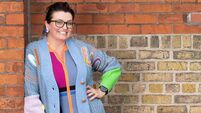Colm O'Regan: I'm fond of the humble QR code

Colm O'Regan: Do you know what QR stands for?
There’s one in our school yard.. A simple little poster.
“Scan with your phone to take part in this survey.”
Dead easy. No one is being asked to remember or type anything. Just a little black and white box with boxy shapes that look like a load of Space Invaders meeting.
It’s the QR code. QR stands for Quick Response code, a fact I found out about three seconds before I typed that. I never thought to look before.
But something about seeing the QR code in a laminated sheet being lashed by the worst rain and wind, but still get its information across, made me look it up out of respect.
Invented by Masahiro Hara of the Denso Wave corporation in 1994, it was originally used to keep track of automotive parts. It can store information as numbers, letters, binary (computer code) and kanji (Chinese characters). So now you know. You are armed with a CLASSIC small talk input for a wedding.
For a long time it was abstract. A weird bar code. Bar codes are ubiquitous. Numbers, lines of different thickness. The bip of the self-service, the prelude to Unexpected Item In Bagging Area. Ballincollig buffs will know that the old L&N near the western roundabout is the site of the first bar code scanners in Ireland, but others probably take them for granted. It’s the same principle. But the QR seemed a step TOO far for most of us.
You may have had the QR code app on your phone from that one time where you were in the Sagrada Familia or somewhere suitably European.
To learn further information in English, the museum suggested “downloading a thing”. And whatever move you made, didn’t you find yourself with a QR code app on your phone.
It gathered digital dust there until July 2020 when we were first allowed into the restaurants and hotels. And as we sat down for that first time, we realised we were welcome — but with caveats.
“If you don’t mind, would you be so good as to touch nothing and avoid humans as much as possible?”
The tables were spartan. Whereas before a menu appeared within four seconds, now there was a black-and-white codey thing.
Most of use still said “…em.. could I speak to a human?” But slowly more and more of us pointed a camera suspiciously at it. Or downloaded the app and then a website opened and we got confused and then we still asked to speak to a human.
But the seed was sown. Pointing your phone at a thing and being transported away. To somewhere mundane, yes, but I don’t care. I’m still kind of fond of it.
It’s a small bit of magic.
You think: “This won’t work.”
But no! There are you are, whisked away to the council website to report the illegal dumping of a mattress or an overflowing drain.
“These yokes are only a code” you mutter at a fundraiser, but still there you are at the raffle-ticket-buying website, contributing more than if it you had had cash.
I think like them because they’re so simple. But they solve that most basic of problems.
How do you get people to go to a place with an address when they simply can’t or won’t type the address? They’re like a postcode for people who don’t want to type a postcode.
People have them on business cards now. You can bring customers to your Linkedin if you want so they can congratulate you on your new position with ShoeWalrus, the exciting new software platform.
In a world where most tech is complicated and possibly not necessary, for me anyway, a humble little QR is QI.
Speaking of humble, Colm’s award nominated book Climate Worrier is available in all bookish places this Christmas!






